Seahawks Losing the 'Tuff' Cover 3 Buzz and Sky Scheme Battle

The Seattle Seahawks are battling on the back-end. With such a focus on stopping the run, placing linebackers down at the line of scrimmage, and running base personnel, Seattle’s Cover 3 is getting worked by opposing offenses. This is the story of the schematic duel Pete Carroll, Ken Norton Jr, and passing game coordinator Andre Curtis are fighting in 2019.
We all know that the Seahawks are a Cover 3 team first and foremost. Even in a post-Earl Thomas world; where the usage of middle of the field open defenses like Cover 2, 4, and 6 has increased; Seattle’s main pass defense is three-deep zones and four underneath. What is less covered is that, put in the simplest form, the Seahawks only run two types of Cover 3.
These are Cover 3 “Buzz” and Cover 3 “Sky." Both the monikers refer to where the down safety fits into one of the four underneath zones. In “Buzz," the safety rotates down into a hook, one of the two middle underneath zones. In "Sky," the safety spins down into a curl-flat, one of the two outside underneath zones. The other safety is left playing deep in “Buzz” and “Sky."
When the safety rotates downwards into a hook and Cover 3 “Buzz," the movement is called either “Rita” (Right Inside) or “Linda” (Left Inside). When the safety is rotating down outside, in Cover 3 “Sky,” the spin is called “Roger” (Right Outside) or “Lou” (Left Outside).
Should say that "Rita" means "Right Inside Rotation" for Seattle's safeties.
— Under Zone X (Frisco)/Phoenix Check/Stick Slasher2 (@mattyfbrown) July 17, 2019
RITA= Right Inside Rotation
LINDA= Left Inside Rotation
ROGER= Right Outside Rotation
LOU= Left Outside Rotation
Thanks to @btrossler for quizzing me on Seattle's coverage. It's sharpened my thinking.
Confusingly, coach Pete Carroll calls his curl-flat defender a buzz defender in order to emphasize the importance of starting with depth and then buzzing to the flat if necessary.
Up front, the Seahawks have been keen this season to stop the run. Their high usage of base personnel, featuring four defensive linemen and three linebackers, is the immediate evidence. Their offseason acquisitions also suggested that fixing the run defense was a priority of the roster-building process.
Using “Tuff” alignments has been more proof. In 2018, the Seahawks attempted to slow the historically efficient Los Angeles Rams wide zone run game by lining up in a bear front that placed three defensive linemen in the interior run gaps (B, A, B) and two EDGE defenders on the perimeter with force assignments. It sort of worked, but left coverage weak on the back-end and did not have the desired effect overall.
Then the New England Patriots eviscerated the Rams on the Super Bowl stage with their 6-1 defensive front, using a similar blueprint to that of Vic Fangio’s Chicago Bears defense in Week 14. First Rams offensive play of Super Bowl:
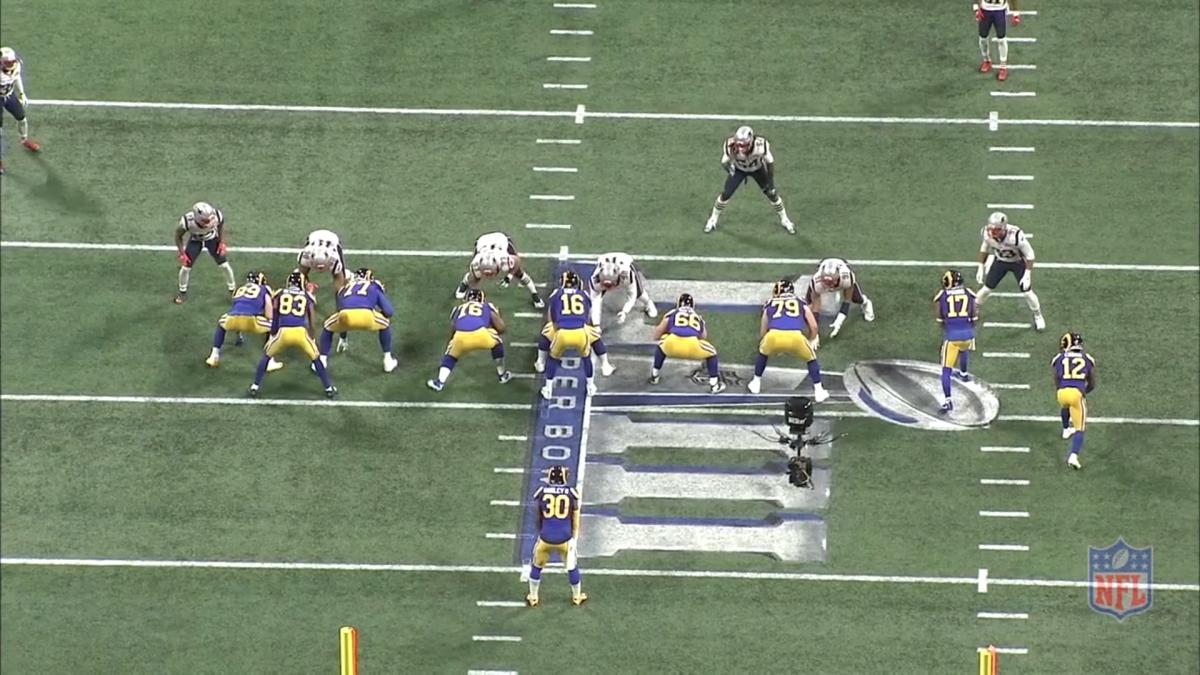
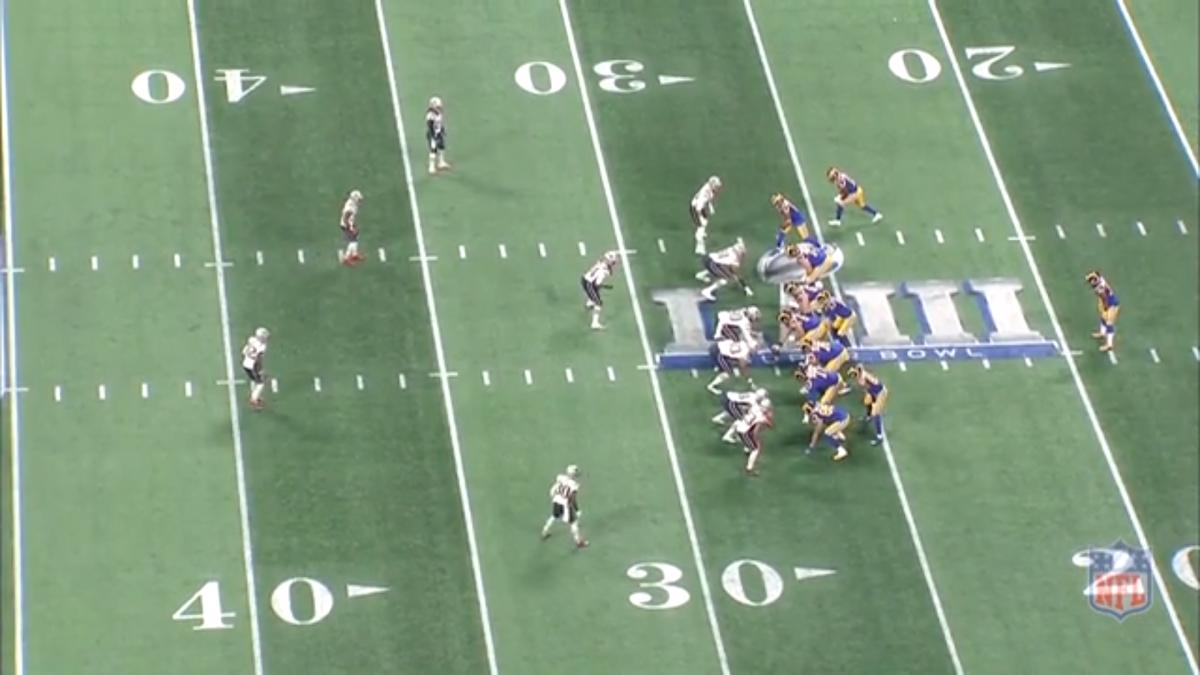
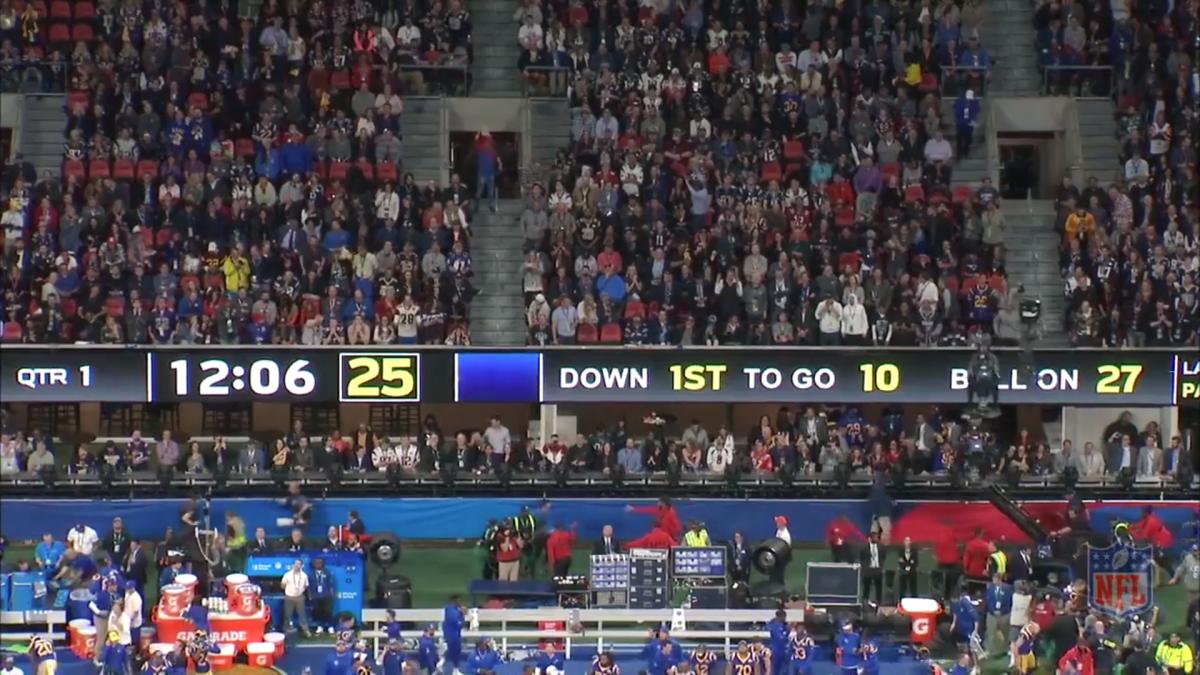
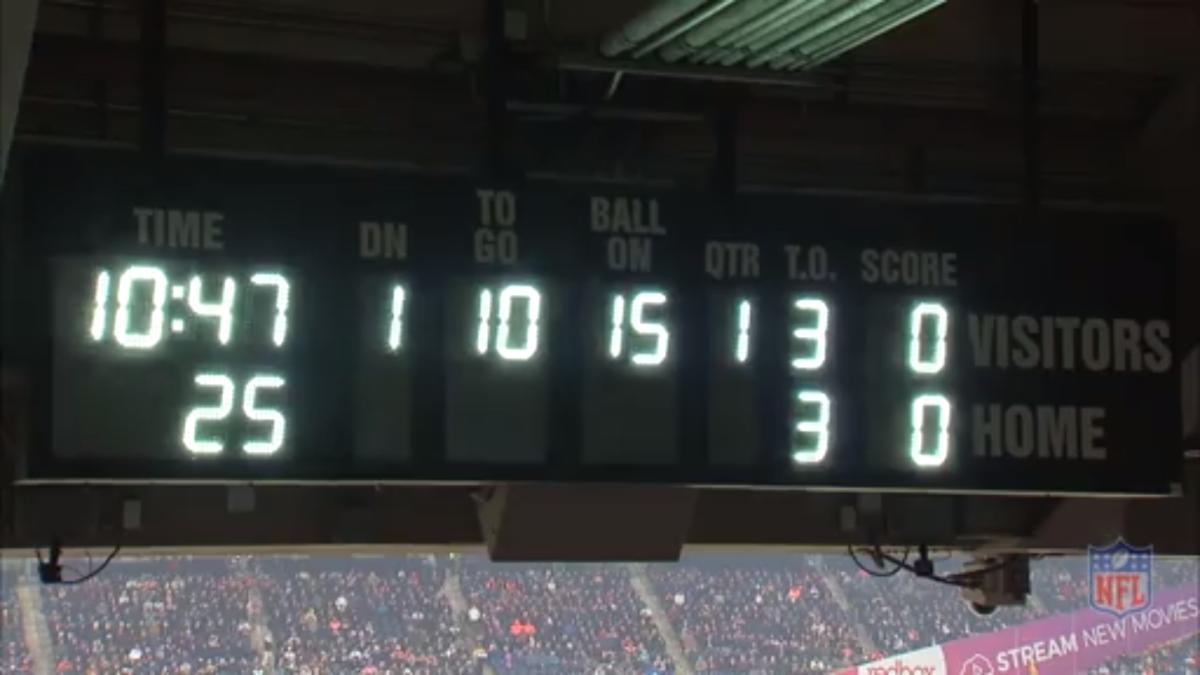
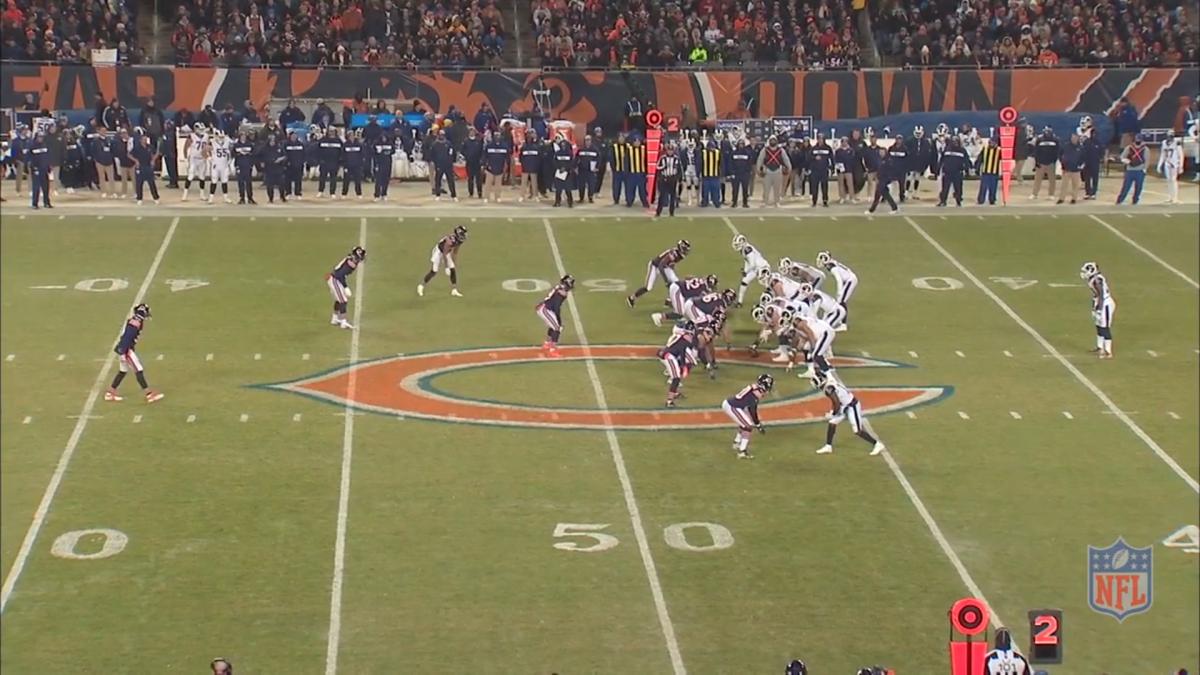
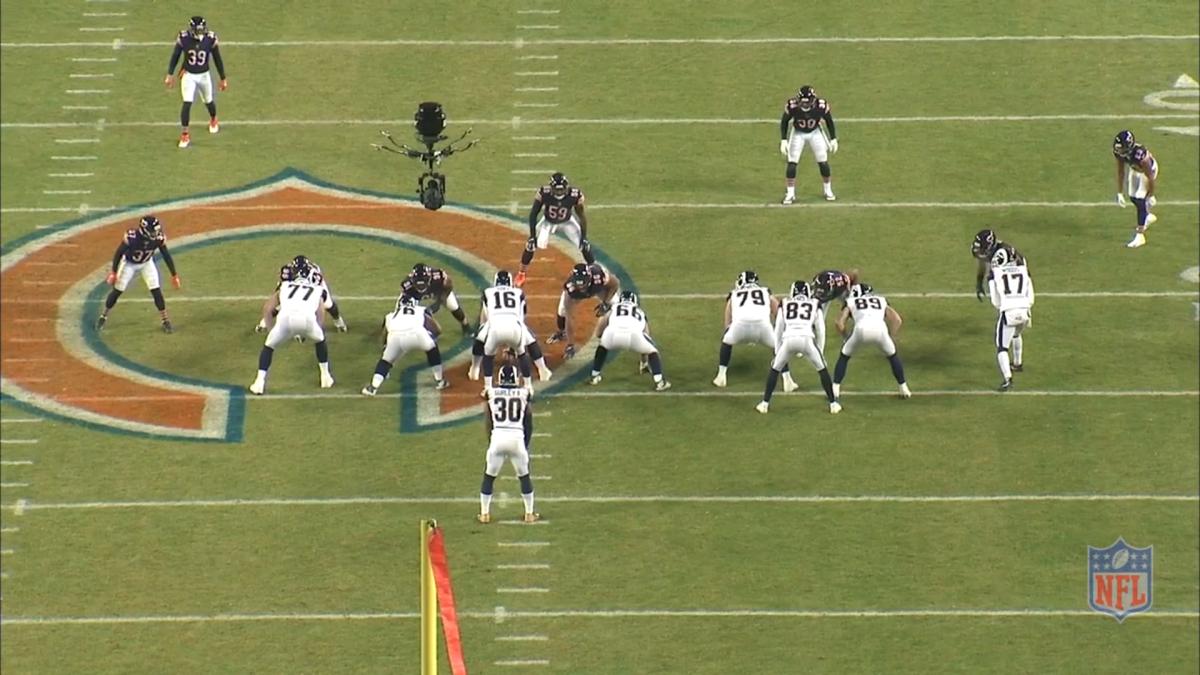
The Seahawks playbook has contained 6-1 fronts since Carroll arrived in 2011. The embarrassment of Sean McVay and Jared Goff was a re-awakening for Seattle’s defensive scheme though. This was the way to halt the prolific wide zone.
“Tuff” alignments are how the Seahawks achieve this 6-1 appearance. They place their strongside linebacker, Mychal Kendricks, at the line of scrimmage in a “down” assignment. From there, he can stunt and twist, but primarily force the run back inside of him as a “hammer” in the run fit.
To get into 6-1, Seattle will place the weakside linebacker, K.J. Wright, opposite Kendricks and down at the line of scrimmage also. Sometimes they switch Wright with a strong safety, as shown in the below example from Week 2 @ Pittsburgh with Lano Hill.
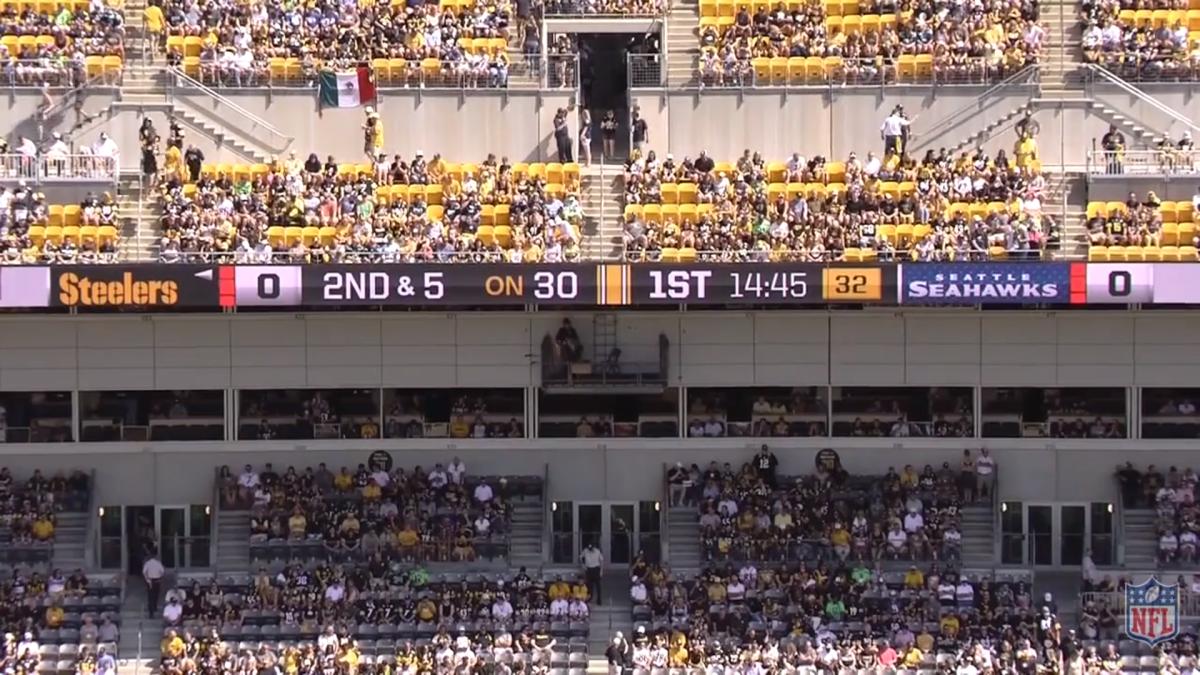
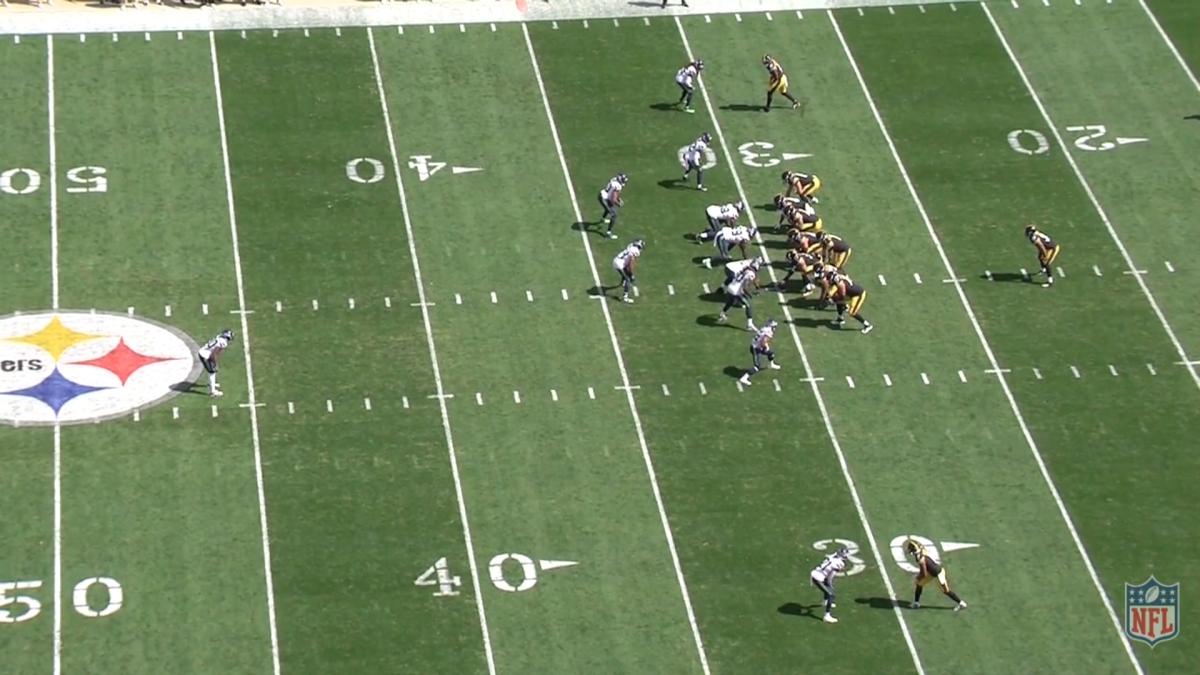
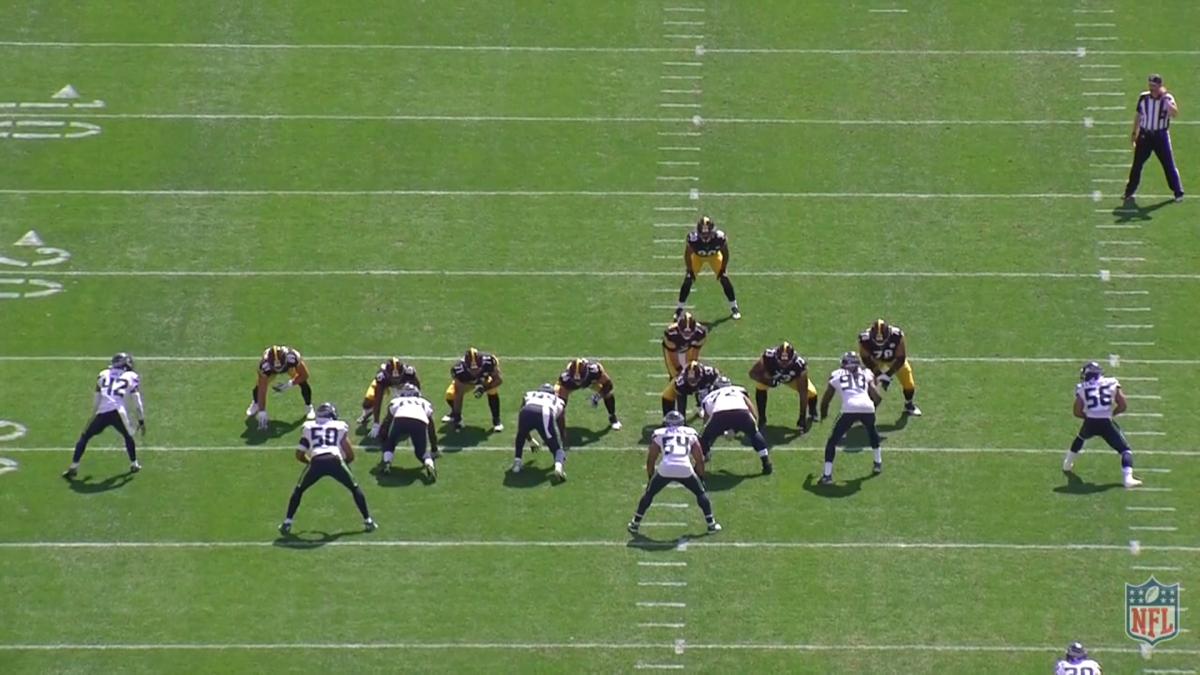
This brings us to Cover 3 "Sky" and Cover 3 "Buzz" again. The coverage must marry itself/accommodate/accompany the "Tuff" alignments and defensive fronts in general.
In 2018, play action over routes repeatedly gashed Seattle’s defense into a bloody mess fit for the goriest of horror movies. The intermediate crossers off play-fakes are something 6-1 stops nicely when running Cover 3 “Buzz." By holding a two-high safety look pre-snap and then staggering the depth of the two inside hooks, the Seahawks defense is able to get multiple layers of coverage.
This is ideal against play action, where most concepts look to stress three layers of the defense. By rotating their safety down late into a Cover 3 "Buzz" defense, Seattle has nerfed the concept which murdered them last year.
Zac Taylor, he of the evil McVay mindset, attempted to get the Seahawks with the over route in the first game of 2019. Safety Bradley McDougald, assigned the weak hook Rita rotation, took away Andy Dalton’s primary read on the first and 10 early in the ball game.
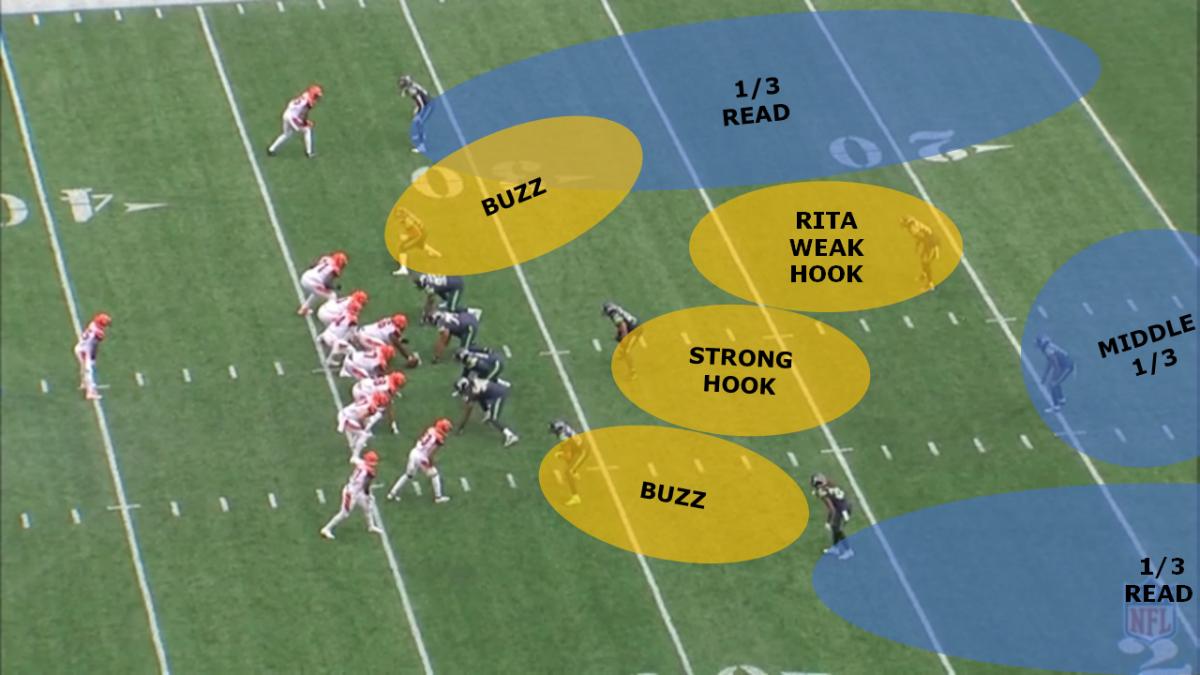
The safety was aided by his initial starting depth. He settled on the hash-mark and forced Tyler Boyd to turn his crossing pattern into a hitch. McDougald was visioning the quarterback all the way and would have been able to make a play on any potential throw to Boyd. McDougald deserves further acclaim for then sticking with Boyd as the play broke down.
By removing Dalton’s primary read of a two-downfield-route design, Seattle was able to eventually move the Bengals quarterback from his spot and Dalton was left throwing the ball harmlessly out of bounds. Nothing was open.
Rather than nailing down on the Yankee-Crosser, the thing Boyd was initially running, Seattle has their deep middle of field safety run with the deepest route, the post, and then still manages to get two layers of coverage for the primary read—the crosser—thanks to the staggered depths of the hooks in Cover 3 “Buzz” run from 6-1 looks.
McVay himself was keen to get the over routes going in Week 5, but to little avail. His receivers were frequently forced to nestle their crossing routes into hitches due to the effectiveness of how the Seahawks were playing their Cover 3 “Buzz." Even on one of the biggest Rams plays in the Thursday Night Football encounter, we saw Seattle’s staggered hooks do excellent work.
McVay gave Goff the alert “leak” route off the bootleg play-fake, looking to test cornerback Tre Flowers. But Flowers read the play well and stayed patient in his deep third, waiting for the leak route and blanketing it. Goff was forced to progress to the three-level flood he had to his right.
In the flats, Wright moved well with the flow of the boot and bullied Johnny Mundt’s route. This, with Goff naked, was likely to be the first thing the signal caller looked to hit.
McDougald, who had started in the Rita weak hook, showcased excellent ROBOT technique versus the deepest route to the sideline, getting in the hip pocket and turning expertly with Josh Reynolds. Goff couldn’t throw it here.
The passer’s next read was the intermediate of tight end Gerald Everett, but Bobby Wagner melted excellently with the rollout and plastered Everett, glancing to check he was underneath the target.
Then it all went wrong, an instance of the frequent futility of playing defense in the NFL. Wagner, thinking Everett was continuing to the sideline, decided to attack Goff. After all, the quarterback looked like he was taking off. Unfortunately, particularly given Seattle had other defenders ready to get Goff, Everett nestled down smartly and ran back inside. He got his big catch and run, but only because of play-extension. The initial defense worked brilliantly.
Of course, Taylor and McVay did have scheme-beating answers for the Cover 3 “Buzz” with “Tuff” alignments. The key was exploiting how Seattle plays single receiver alignments with their cornerbacks. The coached technique is described as 1/3 "Read." It sees the corner play man on any routes into his deep third zone; essentially it’s man on deep.
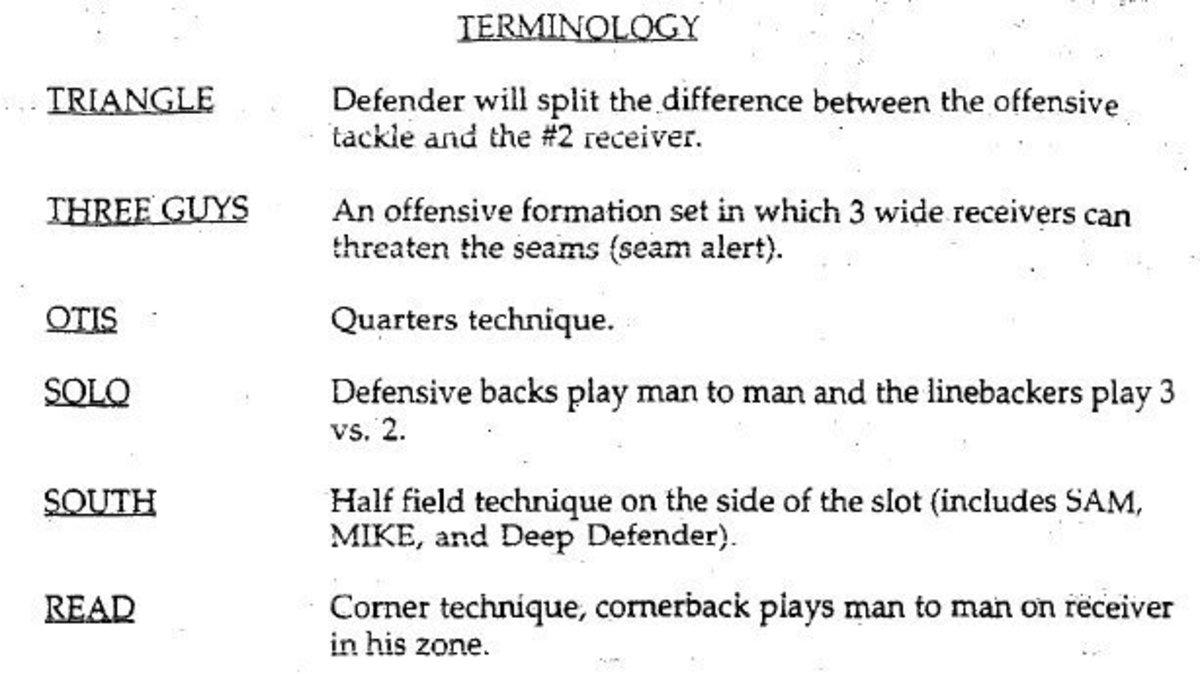
Taylor beat it with a fancy flea flicker. With Kendricks down at the line of scrimmage, he stepped upwards to play the run given he was the force defender and hammer in the fit. The pre-snap jet motion of John Ross to the boundary side of the field happened so fast that Flowers was unable to adjust his deep third technique.
As a result, Flowers was run off in his "Read" 1/3 by the post route of Boyd. Meanwhile, as Joe Mixon pitched the ball pack to Dalton, Ross was wider and behind Kendricks' curl-flat zone. Ross, holder of the fastest 40-yard dash title at 4.22 seconds, is always going to out-run Kendricks and there was no way he was getting caught with this head start. This was one of the easiest long touchdown throws of Dalton’s career. The post-wheel flea flicker flooded Seattle’s Cover 3.
Seattle Seahawks cover 3 buzz with 6-1 front v Cincinnati Bengals Flea flicker Post-Wheel pic.twitter.com/ylrBHEAggh
— Ultra Rare Tape (@UltraRareTape) October 18, 2019
McVay wasn’t as elaborate, running almost the same play off plain-old play-action. Robert Woods has serious wheels, far faster than his 4.51 second combine testing suggests, and his jet motion to a wheel route got him in the same pocket of space that Ross had enjoyed. Kendricks seemed more alert to the danger, but he needed to push wider in his curl-flat drop and be more aware of Woods’ route. This is a common issue with Kendricks at SAM linebacker.
Flowers appeared to play with more “Zebra 1/3” principles. This is the technique Seattle often asks of their cornerbacks when they face more than one threat on their side of the field. Essentially, it sees them midpoint and dissect two vertical routes and play more with “zone eyes” and “landmark” elements.
Perhaps if Flowers had been run off by a more convincing route, or a post that would have taken him inside, he wouldn’t have been able to limit this play. As it was, the go-route of Brandin Cooks enabled Flowers to prevent this play from being a disaster on the level of the Ross touchdown.
Seattle Seahawks cover 3 buzz with 6-1 front v Los Angeles Rams Play-Action Go-Wheel pic.twitter.com/VqoLf4tDfm
— Ultra Rare Tape (@UltraRareTape) October 18, 2019
It’s good to be lucky, but more convincing answers were required for Seattle. Having their outside linebackers down at the line of scrimmage, as force defenders, and then tasked with dropping to the curl-flat, where they should carry vertical routes to the cornerback behind, was too great of a conflict for them versus clever schemers. A change was needed.
This is where Cover 3 "Sky" comes in. All season long, we have seen Seattle rotating their safety down towards receiver stacks. Meanwhile, Kendricks at SAM linebacker was able to play a weak hook, instead of the curl-flat, that saw him drop straight back from his starting alignment.
By taking this "Sky" approach, Kendricks had run-pass conflict largely removed and the Seahawks had a safety starting from depth able to bullet downhill against wide receiver screens - a likely combination from stacked receivers.
Week 6 on the road in Cleveland demonstrated this missilling nature. To a quarterback, the flats look mighty tempting with Seattle holding a two-high shell. Baker Mayfield, reading Kendricks on this inside zone/slant-flat Run-Pass Option, must have been thinking serious yardage when Kendricks crashed inside to play the run.
Mayfield chucked it out to the flat towards Jarvis Landry. Then the fun for Seattle began. Tedric Thompson in a Roger rotation was the assigned curl-flat defender on this play in the Cover 3 "Sky." As soon as he saw the No. 2 receiver, Landry, release to the flat, Thompson knew he was free to fire downhill. (Versus 2x2 formations Seattle frequently assigns their down safety, Thompson in this case, a seam alert match called “Soft Sky.")
Thompson met Landry just after the catch point, limiting the gain to a meager three yards which would have surprised the Browns based on the pre-snap look. Kendricks, rather than worrying about needing to get under the slant-flat concepts Cleveland was hitting all day, instead had a simpler strong hook underneath. That left him free to hunt this inside zone away. Essentially, Seattle forced the throw option of the RPO from Cleveland and made the stop.
Seattle Seahawks cover 3 sky with 6-1 front v Cleveland Browns Inside Zone/Slant-Flat RPO pic.twitter.com/IsHOhNy62P
— Ultra Rare Tape (@UltraRareTape) October 18, 2019
Cover 3 "Sky" is also an intelligent answer to the post-wheel concepts and other dastardly designs that prey on running off the deep third cornerback and throwing it in behind a conflict “Tuff” alignment linebacker.
Sean McVay was feeling particularly wicked on this second and 8 high redzone call up 26-24 with 13.24 left in the game. It was a shot play looking to finish the Seahawks off for good. Aligning in a trips nub formation, McVay ran Wagner off with the No. 3 receiver’s bender route. Wagner got the chance to show his brilliant ROBOT technique in the weak hook match, but it didn't matter on this play.
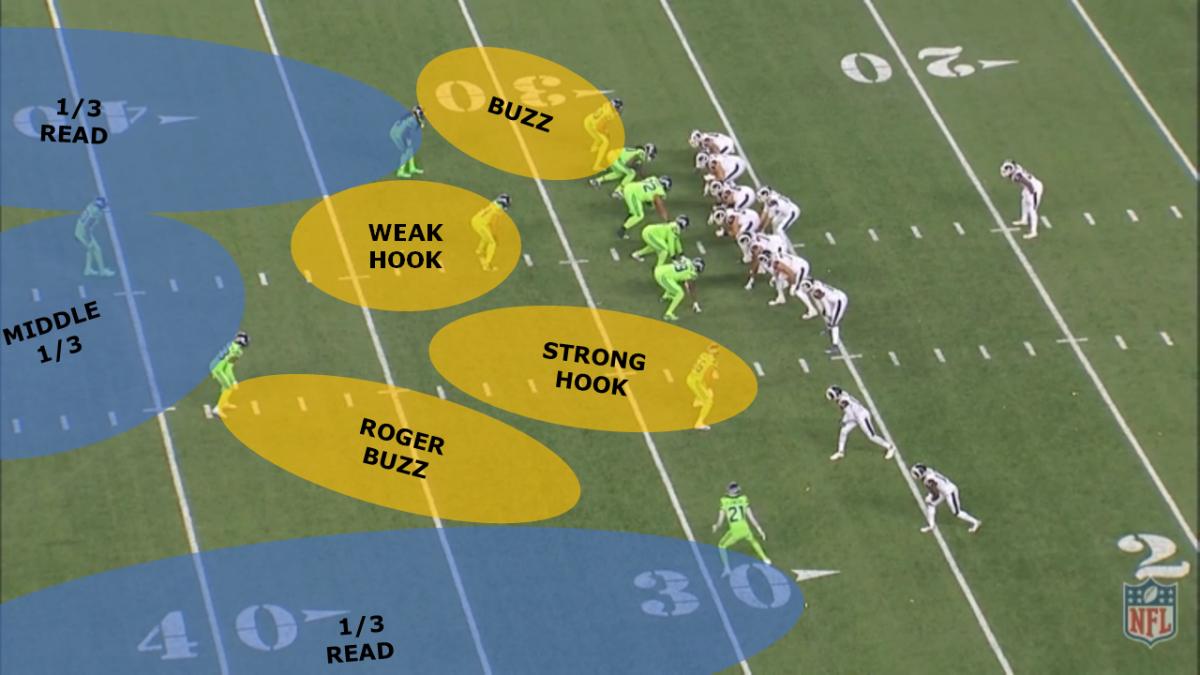
McVay was hoping that Kendricks was the buzz defender, the man in the curl-flat. Instead, Thompson was the player assigned that after a Roger rotation. Kendricks was given a relatively low conflict strong hook that saw him drop back on the hash mark he started at. Thompson was able to stay over the top and in phase with the wheel route of Woods, aided by his initial starting depth.
Flowers, nice that he was on the same page with Thompson, squeezed the nestled post route of Cooks fairly well. McVay wanted Goff to be able to throw the wheel behind a conflicted Kendricks and in front of a run-off Flowers.
Instead, Goff was left looking to his primary read, which was well-covered by Thompson, and then progressing to the nestled post of Cooks. In the time it took him to read what was going on coverage-wise, Jadeveon Clowney was able to pressure him up front.
There was a window for the throw to Cooks, but Goff was unable to step into his attempt. Even if the ball had been completed, staying over the top of everything and forcing more difficult throws is exactly the kind of thing the Seahawks want to be doing.
Seattle Seahawks cover 3 sky with 6-1 front v Los Angeles Rams Play-Action Post (nestled)-Wheel pic.twitter.com/ZAGxWYYU76
— Ultra Rare Tape (@UltraRareTape) October 18, 2019
Don’t think that this is the end of it though. Kitchens schemed his butt off last Sunday, although he did appear to use most of his beaters in the first half. Nonetheless, his dissection of Cover 3 "Sky" with play-action leak deserves applause.
Yes, Kendricks was still in a “Tuff” alignment, likely influenced by the Browns coming out in an under center trips formation. Ken Norton Jr. probably wanted to try and get one-on-one match-ups for his defensive line by having Kendricks down there, plus get run numbers to the strongside and leave Kendricks as the backside contain run fit.
So many things went wrong on this play though. As Ricky Seals-Jones went shallow across the formation, Flowers followed him as though playing a 1/3 "Read" technique. At this stage in the route, there is no way that Flowers should have considered this deep as it was not deep nor was it threatening his zone.
Flowers' movement was made even more bemusing by the fact that the cornerback was facing a trips bunch that usually has Seattle ask the corner on that side to play “Zebra” or pure zone principles that would have seen Flowers play midpoint zone all the way.
With Seals-Jones being shallow, Wagner in the weak hook had no final No. 3 receiver to match so played more of a landmark hook. He still had take-back rules on the backside of trips, but must have presumed he was passing this off to Kendricks. However, Kendricks was too shallow and did not locate Seals-Jones one bit.
Behind Kendricks was a heck of a lot of space as cornerback Shaquill Griffin, who played his assignment correctly, was completely run off by the skinny post route in his 1/3 "Read" technique that saw him play man on deep.
Due to Flowers’ unusual decision to run across the field, Bradley McDougald vacated the middle of the field where he could maybe have made a play on Seals-Jones and ran to the trips side to help the other buzz defender, and Roger rotation down safety, Lano Hill.
Hill had actually done a great job hanging with the vertical route to his side of the field. This is the type of thing Kendricks needed to be far more aware of after registering pass, even if Flowers didn’t help him here.
Seattle Seahawks cover 3 sky with 5-2 front v Cleveland Browns Play-Action Leak pic.twitter.com/aO3McwHl8D
— Ultra Rare Tape (@UltraRareTape) October 18, 2019
“We misplayed the tight end route,” Carroll said about the play on Wednesday. "It’s a scheme that we understand, we’ve seen it but it’s an intricate seam, scheme, and they did a nice job with it, hit it just right and we should have played the play.” Looking at how Seattle played the previously covered Rams' play-action leak gives us an idea of what the Seahawks should have done, but "Sky" made this harder to play than "Buzz."
“We messed up a play against Cincin, Cleveland, excuse me, that got up the sidelines on us. It shouldn’t have happened,” Carroll continued, clearly thinking of the Ross flea flicker when he misspoke. “There’s been a couple of those during the course of the season, a couple of plays that got away from us.”
Seattle’s second half adjustment to the trips bunch formation was to play a middle of the field open defense that featured two deep-half safeties that could stay on top of things. At a certain point, Kendricks will exhaust his opportunities at SAM linebacker. Flowers needs to grow more aware too.
It’s important in this conclusion to stress that no coverage can stop every single concept. Yet, right now, the Seahawks are giving up explosive plays in the passing game that are being caused by them losing the scheme battle.
There has been shoddy execution too. Tedric Thompson is the main man to blame from a general standpoint, but Kendricks must be more aware when dropping back to his curl-flat from the "Tuff" alignment. Yes, he is conflicted, but once diagnosing pass his process is poor. Moreover, on a defense that preaches “no seams, no posts” and “no explosives," a re-think of when and where to use "Tuff" alignments might be required.
